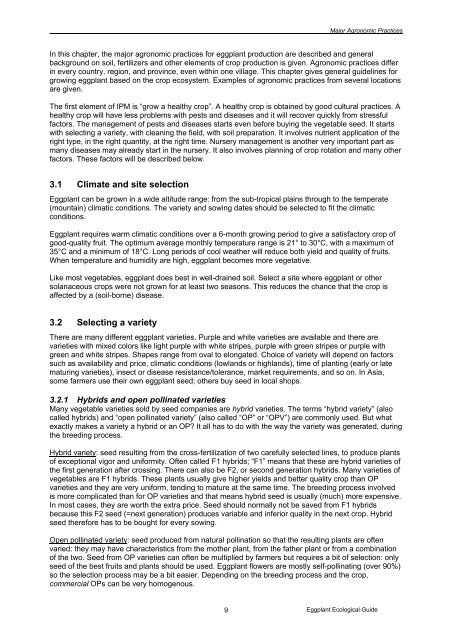Eggplant Integrated Pest Management AN ECOLOGICAL GUIDE
Eggplant Integrated Pest Management AN ECOLOGICAL GUIDE
Eggplant Integrated Pest Management AN ECOLOGICAL GUIDE
Create successful ePaper yourself
Turn your PDF publications into a flip-book with our unique Google optimized e-Paper software.
___________________________________________________________________________________Major Agronomic PracticesIn this chapter, the major agronomic practices for eggplant production are described and generalbackground on soil, fertilizers and other elements of crop production is given. Agronomic practices differin every country, region, and province, even within one village. This chapter gives general guidelines forgrowing eggplant based on the crop ecosystem. Examples of agronomic practices from several locationsare given.The first element of IPM is “grow a healthy crop”. A healthy crop is obtained by good cultural practices. Ahealthy crop will have less problems with pests and diseases and it will recover quickly from stressfulfactors. The management of pests and diseases starts even before buying the vegetable seed. It startswith selecting a variety, with cleaning the field, with soil preparation. It involves nutrient application of theright type, in the right quantity, at the right time. Nursery management is another very important part asmany diseases may already start in the nursery. It also involves planning of crop rotation and many otherfactors. These factors will be described below.3.1 Climate and site selection<strong>Eggplant</strong> can be grown in a wide altitude range: from the sub-tropical plains through to the temperate(mountain) climatic conditions. The variety and sowing dates should be selected to fit the climaticconditions.<strong>Eggplant</strong> requires warm climatic conditions over a 6-month growing period to give a satisfactory crop ofgood-quality fruit. The optimum average monthly temperature range is 21° to 30°C, with a maximum of35°C and a minimum of 18°C. Long periods of cool weather will reduce both yield and quality of fruits.When temperature and humidity are high, eggplant becomes more vegetative.Like most vegetables, eggplant does best in well-drained soil. Select a site where eggplant or othersolanaceous crops were not grown for at least two seasons. This reduces the chance that the crop isaffected by a (soil-borne) disease.3.2 Selecting a varietyThere are many different eggplant varieties. Purple and white varieties are available and there arevarieties with mixed colors like light purple with white stripes, purple with green stripes or purple withgreen and white stripes. Shapes range from oval to elongated. Choice of variety will depend on factorssuch as availability and price, climatic conditions (lowlands or highlands), time of planting (early or latematuring varieties), insect or disease resistance/tolerance, market requirements, and so on. In Asia,some farmers use their own eggplant seed; others buy seed in local shops.3.2.1 Hybrids and open pollinated varietiesMany vegetable varieties sold by seed companies are hybrid varieties. The terms “hybrid variety” (alsocalled hybrids) and “open pollinated variety” (also called “OP” or “OPV”) are commonly used. But whatexactly makes a variety a hybrid or an OP? It all has to do with the way the variety was generated, duringthe breeding process.Hybrid variety: seed resulting from the cross-fertilization of two carefully selected lines, to produce plantsof exceptional vigor and uniformity. Often called F1 hybrids; “F1” means that these are hybrid varieties ofthe first generation after crossing. There can also be F2, or second generation hybrids. Many varieties ofvegetables are F1 hybrids. These plants usually give higher yields and better quality crop than OPvarieties and they are very uniform, tending to mature at the same time. The breeding process involvedis more complicated than for OP varieties and that means hybrid seed is usually (much) more expensive.In most cases, they are worth the extra price. Seed should normally not be saved from F1 hybridsbecause this F2 seed (=next generation) produces variable and inferior quality in the next crop. Hybridseed therefore has to be bought for every sowing.Open pollinated variety: seed produced from natural pollination so that the resulting plants are oftenvaried: they may have characteristics from the mother plant, from the father plant or from a combinationof the two. Seed from OP varieties can often be multiplied by farmers but requires a bit of selection: onlyseed of the best fruits and plants should be used. <strong>Eggplant</strong> flowers are mostly self-pollinating (over 90%)so the selection process may be a bit easier. Depending on the breeding process and the crop,commercial OPs can be very homogenous.9<strong>Eggplant</strong> Ecological Guide




![Section 4 [ PDF file, 252 KB] - The Field Alliance](https://img.yumpu.com/51387260/1/158x260/section-4-pdf-file-252-kb-the-field-alliance.jpg?quality=85)











